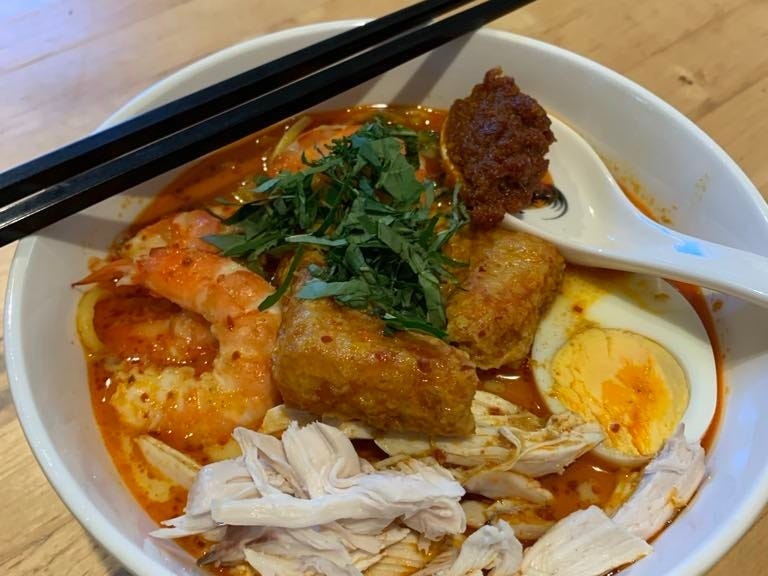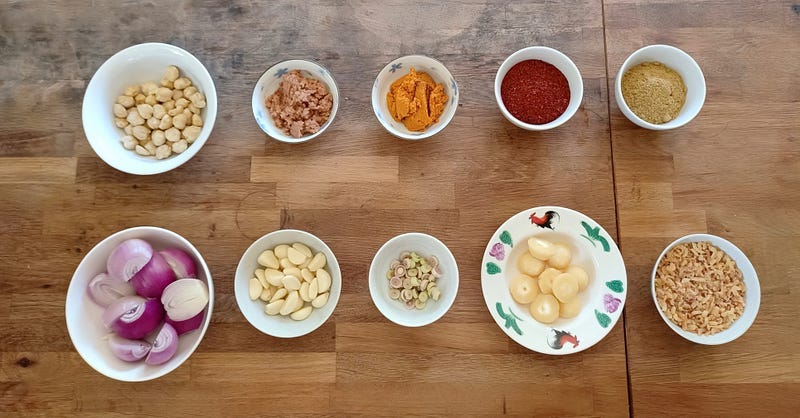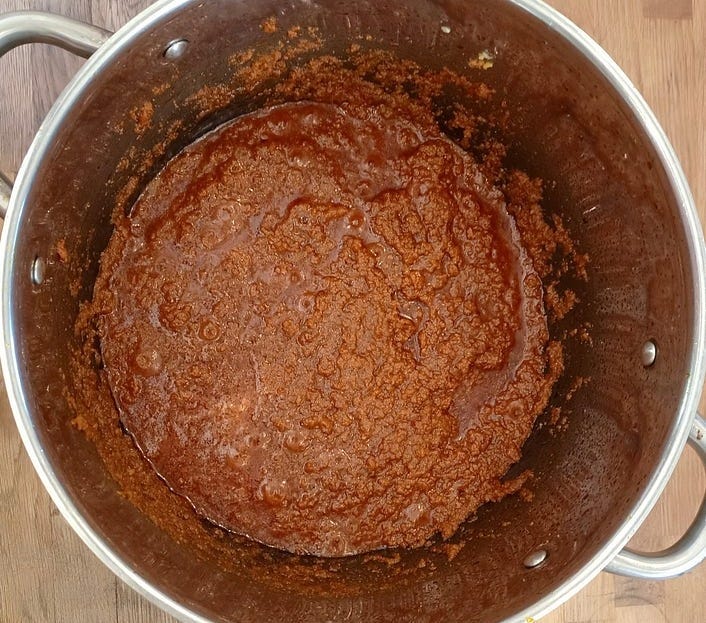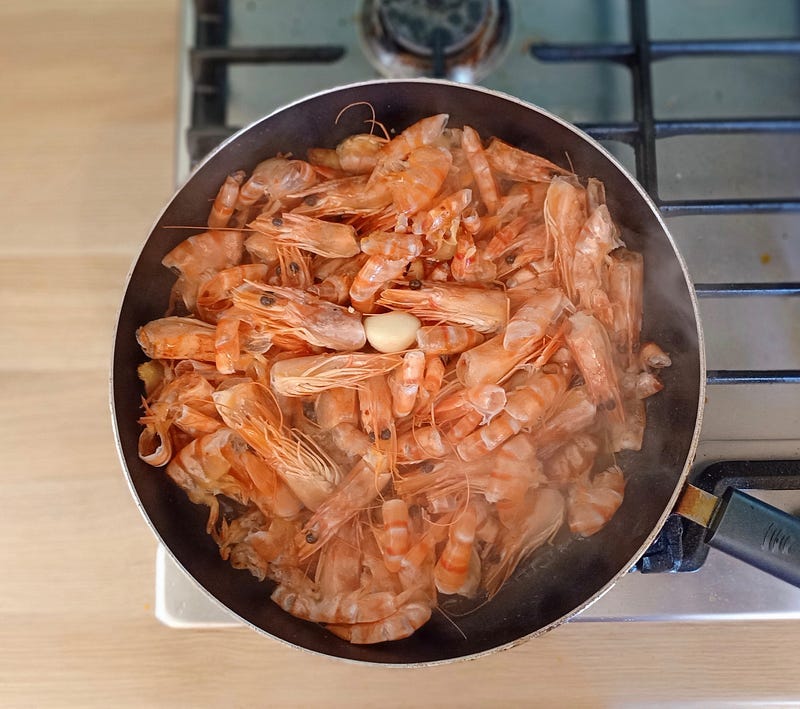Laksa is easy
Making a good laksa is as hard as you want it to be. Like most things in life.
I never really liked Laksa that much.
Growing up in Singapore, there were infinitely more dishes to choose from. I don’t dislike it; it’s just not my favourite.
Six months after we migrated to Adelaide, I began craving it. We are lucky that most ingredients are now available at most Asian grocery stores. I was told that in the 1960s, you could hardly find a bottle of light soy sauce.
Ten years after we arrived in South Australia, I learned to cook enough Singaporean dishes to open Lot 8 at Aldinga, a restaurant that serves Singaporean food.
Our most popular dish during the five years we were open for business was Nonya Laksa. I am often asked for the recipe. “It’s easy. I learned about it on YouTube.”
Sorry for not taking the time to explain.
Taking the cue from the positive response to “How to do a hotpot dinner in Aldinga,” I thought I would share the recipe and a little about Nonya Laksa.
The Origin of “Laksa”
No one knows.
One of many theories is that the word “Laksa” originates from the Chinese words spicy (辣) and grainy or sandy (沙). It originated from Peranakan culture in the 16th century, when Chinese migrants, who introduced noodles to Southeast Asia, intermarried with local Malays and used local ingredients and spices to create this and other Peranakan dishes.
Wikipedia: …the word laksa is theorised to come from an ancient Persian word for “noodles”.[8] According to Denys Lombard in the book Le carrefour Javanais. Essai d’histoire globale II (The Javanese Crossroads: Towards a Global History, 2005), one of the earliest record of the word laksa to describe noodles was found in the Javanese Biluluk inscription dated from 1391 of Majapahit era that mentions the word hanglaksa. Hanglaksa in Kawi means “vermicelli maker”. [10] In Sanskrit, laksa means “one hundred thousand”, referring to numerous strands of the vermicelli. The term laksa or lakhshah is also believed to have come from Persian or Hindi which refer to a kind of vermicelli. [10]
In any case, there are 2 popular versions of laksa in Singapore and Malaysia: the coconut-based Nonya Laksa, which was what we were serving at Lot 8, and the tamarind-based, fishy, and overly sour Assam Laksa, which I do not like.
A recipe for Nonya Laksa
I must confess that I don’t have a “recipe” in the usual sense. Like my mother and grandmother, I cook based on “agak-agak”, the Malay word for “estimation”. So I wouldn’t be able to tell you the exact amount for each ingredient. I realised it doesn’t matter as long as it tastes right. And I taste as I cook.
I always begin with the rempah, or laksa paste, which is the key element of the dish. The rempah comprises the following:
From left to right, top-to-bottom row.
Bowl of candlenut (you can replace with macadamia nuts as well)
Bowl of galangal (I used minced galangal that comes in a jar, but fresh galangal is better)
Bowl of turmeric (also from a jar)
Bowl of chilli powder or paste. You can use as much as you can tolerate. I prefer Gochugaru (Korean Red Pepper Powder) because the colour is much brighter, though not as spicy. You can use dried chillies, but remember to rehydrate them first.
Bowl of coriander powder
1 kg of red or brown onions (Shallots are too expensive here, and they look like undersized onions anyway. I use whatever is on offer)
A bowl or handful of garlic cloves
Some lemon grass
Some palm sugar. You can use brown or raw sugar, but palm sugar is fancier. More authentic.
Some dried shrimps. This is NOT optional. Also, only available in Asian grocery stores.
Next, blend everything well and fry it over a low fire with an almost equivalent amount of oil. A cup of rempah paste with a cup of oil. You can use vegetable oil or peanut oil. The idea here is to cook until the oil separates. That’s when the paste thickens, with a layer of red oil floating on top. Set aside.
This requires patience. And constant stirring to prevent burning the rempah. You can use this rempah for multiple dishes like dry tossed Wonton Noodles and Nasi Lemak (coconut rice). You can even have it with cheese and crackers, too, like a dip.
The (soup) stock
The stock is the next most important building block. The stock gives the dish depth, so I would ensure it is done properly. I use free-range chicken frames for the stock, but if you like, you can add chicken wings and/or drumsticks. It will taste better.
Put the chicken frames into a deep pot with cold water. Add several slices of ginger, a few bunches of spring onions, unpeeled garlic, and a generous dash of Chinese cooking wine. Bring the pot to a boil, then let it simmer gently for about an hour. When done, filter out the chicken frames and aromatics. Once again, you can use this for many other dishes.
The Toppings
Traditionally, the toppings for Nonya Laksa in Singapore comprise:
Prawns. Poach the peeled prawns in the clear stock for just under a minute.
Chicken. Shred them with your fingers and set aside.
Boiled eggs. Halved.
Tofu Puffs. I usually cut it into pieces and leave it in the final laksa gravy.
Fish cakes. Optional. I love fish cakes, but most Aussies don’t. I wonder why.
Blood cockles. This is one of the key ingredients if you have Laksa in Singapore, but it is virtually impossible to find here in Adelaide. Blood cockles are shellfish found in swamps, but I have tried replacing them with fresh oysters or mussels, and it works, too. Again, it’s optional.
Laksa leaves, or Vietnamese mint. Cut them into thin shreds. This is another key ingredient that gives laksa its unique taste and aroma. You can grow these easily in Australia. Otherwise, Asian Grocery stores will usually have them. If you really can’t find them, replace them with spring onions for colour. It won’t be the same.
Preparing the Prawns
I use raw prawns with the shells on. Peel the prawns and set aside the heads and shells. In a skillet, brown some garlic and add the heads and shells of the prawns. Sauté them until they are nice and brown. Then, add everything to the clear chicken stock and let it simmer for about 15-20 minutes. If it’s any longer than that, it starts to lose flavour.
Remove heads and shells. This will be the base stock for the laksa gravy.
Preparing the Chicken
I usually give the chicken a good rub with salt, then bathe it in boiling water. This tightens the skin and removes any impurities from the skin. It’s also the same process used for preparing poached Hainanese Chicken.
Bring the clear stock to a boil, then gently add the chicken. When the stock comes to a boil, lower the heat and let it simmer for about 10 minutes. Then, and this is important, turn off the heat and put a lid on the pot. Let the chicken sit in the stock for about an hour. This will cook it without overcooking it.
After an hour, remove the chicken from the stock and let it rest.
The laksa broth
Heat lots of rempah (laksa paste) in a pot and add the stock. Let it simmer for a few hours so the broth can absorb the spice from the paste. This is the same reason that overnight curries taste better. It allows the broth to become rich and thick.
Just before serving, add coconut milk. You can use coconut cream, but it makes the gravy thicker. I use about 1 part coconut milk to 2 parts stock for the laksa gravy. I like it thick and very “lemak” (coconutty). Add fish sauce for extra umami as you taste it.
Assemble
In Singapore, laksa is served with thick rice noodles. You can also use Hokkien Noodles. We had a customer who had her laksa with thin egg noodles. That’s very nice, too. It’s up to you. I occasionally have it with steamed rice as well.
Poach the noodles in boiling water for under a minute, with some bean sprouts if you like, and transfer to a nice big bowl. To assemble the laksa, arrange the toppings of your choice on top of the noodles, then ladle the laksa broth onto the noodles and add a pinch of laksa leaves. If you like it with some heat, add a tablespoon of rempah and serve it hot.
Other ways to have Laksa
In Singapore, you can have Laksa Hotpot, Dry Laksa (a braised noodle dish using laksa gravy), Fried Laksa, and even Laksa Instant Noodles. Be creative. But since this dish takes such a long time to prepare, I think it is an occasion for a Weekend Laksa Party (if you start the preparation a day earlier) with lots of friends and family.
I hope you enjoyed this article. While “What Matters” is free, I appreciate your support as a paid subscriber. If you don’t subscribe, you can also buy me a coffee. Either way, it means a lot.
Thank you for being here. Please remember to like, restack, and leave a comment.











